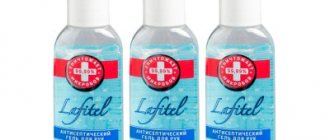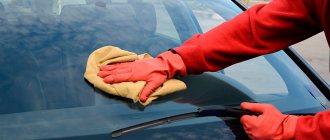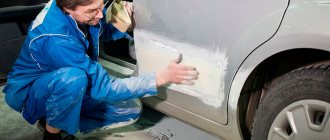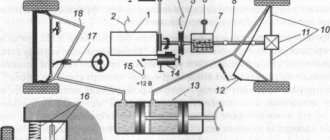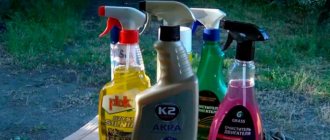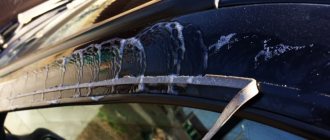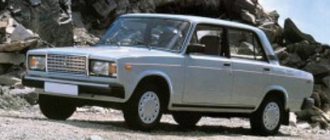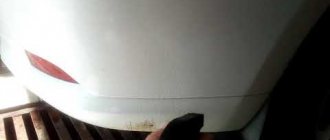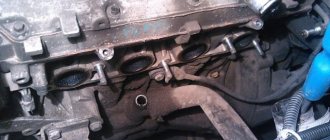How to remove poplar resin, traces of linden and pine from a car body with your own hands
Getting rid of Velcro means making sure that not even a speck remains from the contact of a tree bud with the paintwork.
As already noted, the fourth day is the deadline when the body surface can still be saved without the use of polishing. Later, chemistry is no longer able to remove the famous yellowness that remains after removing the resin. The proposed method is relevant precisely from the moment the poplar, pine or linden tree gets in contact with Velcro until the end of the fourth day:
- Remove buds from the body surface. This must be done so that the resin does not leak out of them. Use the following method: dampen a cloth in warm water, wring it out as much as possible and brush the tree flowering products to the side. Dry rags are not suitable for these purposes - they do not allow brushing. You should not remove it with your hands or a brush - the Velcro will open at the slightest hard touch.
- Wash the outside of the car. Contactless washing is preferred because it leaves fewer scratches.
- Wipe the body dry. There is no need to worry about defective areas - ingrained resin cannot be smeared with a rag.
- Remove tar stains. Soak a piece of cotton wool or a cotton pad in alcohol/acid and, without applying much effort, wipe off the resin. In most cases, the Velcro mark needs to be soaked: place a swab soaked in chemicals on the contaminated area and leave for 10-15 minutes. After soaking, the stain is removed with a slight movement of the hand.
- Final cleaning of the treated area. Produced using special auto chemicals to remove resin. Usually this is any can with the Bug & Tar Remover attachment. The operation is not always necessary; it is done at will.
How to remove epoxy?
Depending on the composition, epoxy resin has a different curing period. The high degree of polymerization and hardening within a few hours require action to be taken as early as possible.
The longer the resin remains on the skin, the higher the risk of developing irritation and allergies.
Folk remedies
The sooner measures are taken to remove the adhesive mass from your hands, the better for the skin, and the easier and faster the cleansing will be. You can use the products you have at home.
Baby cream
A neutral, hypoallergenic and fairly greasy baby cream is a suitable product for quickly removing tarry mass from hands.
The procedure for use is not complicated:
- Apply the product to the skin and distribute over the stain and areas of skin nearby.
- Using a napkin, soft brush or sponge, rub the area vigorously, trying to remove as much resin as possible.
- Repeat application and wiping.
- Wash your hands with soap.
Soda
Baking soda is an affordable product that can almost always be found in the kitchen. Preparation of the cleaning composition includes:
- pour 3 tsp into a bowl. soda;
- pour in 1 tbsp. l. water;
- stir to a paste;
- apply to the stained area of the hands;
- using a brush or napkin, treat from the edges of the stain to the center;
- wash off with soap;
- wipe your hands;
- apply nourishing cream.
Coca-Cola and soda
You can use cola and soda to dissolve the resin. The effect of the drink is explained by the presence of orthophosphoric acid and carbon dioxide. Baking soda powder will complement the effect.
Procedure:
- Pour Coke (1 liter) into a bowl.
- Add 1 tbsp. l. soda
- Mix.
- Dip your hands into the solution so that it covers the areas stained with resin.
- Leave for 10 minutes.
- Wash your hands with soap and a washcloth.
- Wipe your hands.
- Apply with softening nourishing cream.
Household chemicals
Household chemicals that can help remove resin should be used with caution. The best effect is achieved if you start washing your hands before the resin has hardened. The best effect is achieved if you start washing your hands before the resin has hardened.
The best effect is achieved if you start washing your hands before the resin has hardened.
White Spirit
Hand treatment procedure:
- moisten a napkin or sponge with white spirit;
- rub the stained area of skin;
- Using a brush and laundry soap, wash off any remaining resin;
- lubricate your hands with cream.
If the resin has dried, it will take longer and be more difficult to wash it off. The cost of the product is from 80 rubles per liter.
Petrol
To clean off uncured epoxy, you can use refined gasoline. The well-known solvent “Galosha” is suitable for everyone.
Sequencing:
- Moisten the sponge with gasoline.
- Rub the stained area.
- Prepare a weak alkaline solution from 1-2 tbsp. l. soda per liter of water.
- Rinse your hands with an alkaline solution.
- Apply nourishing cream to your hands.
Gasoline "Galosha" costs from 150 rubles per 1 liter.
Acetone
Exposure to acetone is a fairly aggressive method that should only be used as a last resort. Or if other methods are ineffective.
Acetone can be used as a solvent as follows:
- soak the sponge with acetone;
- rub the stained area so that the resin comes off;
- wash your hands with soap;
- apply a rich cream to soften the skin.
The price of a large package of technical acetone (10 l) is 800 rubles. Available in packaging of various sizes.
How to remove it from different surfaces of the car?
If resin gets on open parts of the car, for example, on the body or roof, on the trunk or on the glass, it is not difficult to get rid of it.
Algorithm of actions:
- the car must be rinsed with clean water to remove dust and road dirt;
- soak a soft cloth in hot water and go over the stains;
- those resin traces that are not washed off with soapy water are treated with improvised means or specialized compounds.
Resin on fender flaps, arches and sills spoils their appearance, so you can’t ignore it. To clean these parts, you will need to remove them. Once they are detached, they are soaked in a hot soapy solution for 10-15 minutes.
Those stains that could not be washed off with water are rubbed with detergent solutions. You can use both improvised means and specialized chemicals.
How to clean bitumen from the road?
Bitumen on a car is a common thing for car owners. It is enough to drive along a section of road that is being repaired or is hot, and dark stains from tar will cover the body. They can be removed either with improvised means or with specialized compounds.
Liquids at hand
Folk remedies for getting rid of road tar:
- Petrol. Every motorist always has it with him. You can use it at any convenient time. Gasoline does an excellent job of removing both fresh and old stains, but in the latter case you will have to put in more effort.
It is easy to use; just apply gasoline to a rag and wipe the dirty surface. You need to act carefully, without making much effort, since the paintwork may come off along with the bitumen. Diesel fuel and kerosene have a similar effect.
How to wash poplar buds
Poplar buds are quite difficult to wash. If you cannot avoid the appearance of stains, you will have to resort to the use of special chemical reagents that can remove without harming the surface of the car’s paintwork.
If an unfortunate kidney stain appears on your car, it urgently needs to be eliminated, since time is against you. This is especially true for owners of white cars. Against such a background, it is even more difficult to wash away traces.
To remove poplar buds, use specialized additives for car shampoo. There are special additives for general purposes for detergents that remove stains of various origins from the surface of a car without harming its paint surface. The advantage of this method is its simplicity and practicality.
Specialized products effectively remove traces of poplar buds. Such products, as a rule, are created to remove complex stains. If you have access to a pressure washer, the cleaning process will be even faster.
How to remove and erase poplar stains on a car
Poplar buds, one might say, are a kind of scourge for motorists in the spring and early summer. I didn’t see where I parked the car and bam, in the evening the car was covered in buds and tar. The buds actively fly off the trees before flowering, and some of them land on cars standing under the trees.
So, if you find that poplar buds and, accordingly, resin from them have gotten on your car, then first of all, you need to carefully remove them from the surface of the body. It is best to remove the buds with a wet cloth, having previously wrung it out, or wearing wet cotton gloves. If you clean with your bare hands, then, firstly, you will get dirty yourself, and secondly, the resin sticks to dry material much better than to pre-wetted fabric!
The stains, of course, will still remain. Next, it is best to wash the car, not with your hands, but with a contactless high-pressure washer. But even here, small spots will most likely still remain. And here it begins...
Next, take alcohol and cotton wool, soak the latter in place with ALCOHOL and let it soften. Then we erase the stains. If you are used to perceiving everything in pictures, then we do something like this.
There will be practically nothing left of stains here. To be sure, we treat contaminated areas with specialized liquids designed for cleaning the car body. By the way, there are liquids designed directly for removing poplar resin from the body.
As for the previous option, all materials must be clean, free of sand and dust, to prevent mechanical damage to the paintwork. It is important to note that the final result will depend on your efficiency. If several weeks pass after the paintwork is contaminated, then perhaps the only option that will get rid of stains associated with poplar resin and buds will be mechanical polishing
And even then stains may remain. There will simply be darker spots on the light ones. So vegetable resin is more dangerous for paintwork than tar
If several weeks pass after the paintwork is contaminated, then perhaps the only option that will get rid of stains associated with poplar resin and buds will be mechanical polishing. And even then stains may remain. There will simply be darker spots on the light ones. So plant resin is more dangerous for paintwork than tar.
Note: test review of automotive resin cleaners
Just as in the case of gasoline additives for cleaning injector nozzles, quite a few auto chemical manufacturers have rolled out their anti-bitumen products to the market. There are representatives of both well-known foreign companies and domestic teams.
The magazine "Behind the Wheel" tested products from various manufacturers. The essence of the test procedure was to evaluate the effect after using the drug in full accordance with the instructions. Resin cleaners from the following companies took part in the “race”:
- Liqui Moly (Germany – 475 rubles/400 ml).
- Kangaroo (Korea – 330 rubles/400 ml).
- Grass (Russia – 255 rubles/500 ml).
- Doctor Wax (USA – 690 rubles/475 ml).
- Autoprofi (Russia – 170 rubles/500 ml).
- Astrohim (Russian Federation – 150 rubles/500 ml).
- Sonax (Germany – 460 rubles/300 ml).
- Pingo (Germany – 520 rubles/400 ml).
- Texon (Russia – 140 rubles/520 ml).
Conventionally, products are divided into two groups: fast-acting (Astrochem, Liqui Moly, Kangaru, Avtoprofi, Sonax, Pingo), requiring long exposure (Grass, Tekson). Theoretically, the following is expected: the former do not drain, concentrating the entire volume on the affected area, the latter dissolve stains more effectively, but require more consumption. Practice confirms this.
When choosing, it is important to consider the smell. The procedure for interacting with the drug is often slow, so the aroma should not be strong
Everything is aimed at not causing discomfort to the operator, especially in the heat. The mixture from Astrohim most accurately satisfies these conditions.
Almost all compositions cope with the task with dignity. However, there are still favorites - Texon and Astrohim. At a minimal price, they fulfill their purpose as transparently as possible. Let Tekson complete the task with a significant amount of time (withstand at least 5-10 minutes), but he washes off poplar resin and road petrochemicals the first time.
Use hand sanitizer to remove resin or tree buds from your car.
Together with unscrupulous and incompetent auto mechanics, fines from traffic police cameras and various vehicle malfunctions, tar or buds from trees are also the worst nightmare for any car enthusiast. The fact is that resin and tree buds seriously damage the paintwork of a car body. Due to their chemical composition, it is very, very difficult to wash off tar or buds from the body using traditional methods. Many people resort to various chemicals that are sold in car dealerships, spending a lot of money. Someone goes to a car wash expecting to clean their car of tar and tar stains. But there is an easier way to easily and quickly remove resin from a car body yourself. But most importantly, this method is the cheapest, simplest and has less risk of damaging the body paint.
We have nothing against various special chemicals. But not all products on the market can deal with stubborn stains on a car. On the contrary, some can damage your car during cleaning.
So be careful when choosing a product to remove tar and other very sticky contaminants from your car.
But why waste your time learning a lot of chemicals to clean your car? After all, in any chain grocery supermarket (usually at the checkout) or in any pharmacy you can buy hand sanitizer, which is used by millions of people around the world every day. Using a hand sanitizer, you can, without resorting to other, more costly and time-consuming methods, easily clean your car from contamination with resin and other types of stains caused by trees (especially spruce, poplar).
Firstly, if you see that your car is covered in stains of sticky resin, do not try to clean the body with a damp cloth. This will not help to remove the sticky substance. In any case, you need something more powerful to remove tar from your car.
Here's what you need to do to quickly and easily remove resin, tree buds and other sticky substances that have fallen from trees onto your car's paintwork.
Prepare a hand sanitizer (preferably not cheap and from a well-known brand) to remove the resin.
Resin and tree pollen on the body - is it dangerous and how to deal with it?
At first glance, what could be simpler than soaking a cotton swab in alcohol and wiping the defective area. Despite the simplicity of the operation, there are a couple of subtleties, which means you should not take it so lightly. For example, we rarely immediately observe spots in their pure form. As a rule, the body is dotted with buds, some of which have opened, and some continue to remain closed. So brushing both of them away is not an easy task.
If you have a hair dryer, try cleaning the surface of the car with it. To do this, warm up the area where the poplar resin is sticking well and wipe it with a cotton swab dipped in ammonia, and then with detergent or soapy water. You can try to do the same, but with a regular hair dryer, if it has a high enough power.
You can try to solve the problem with the help of well-known drinks - Pepsi or Coca-Cola. They must be applied according to the instructions described above, constantly monitoring the condition of the car’s coating. At the first sign of a change in paint tone or other changes, immediately wash off the folk remedy with plenty of plain water.
If none of the remedies help or you don’t want to test the strength of your car’s paintwork, contact a service station for a professional cleaning service. The cost of cleaning poplar resin is unlikely to be low, but the main thing is the end result. Please note that some salons quote a price for cleaning the entire car, while others charge the treatment of each stain separately.
Probably, many car enthusiasts have high-pressure devices in their garage or private home and these people wash their cars themselves. There is a special preparation, an additive to the main shampoo, which effectively copes with traces of any insects and poplar buds. The product is sold in any auto stores.
Among the obvious advantages of this composition for combating kidney disease is the complete absence of any damage to the paintwork of the body. Also, using the composition will not cause difficulties and is ideal for use at home. With a high-pressure washer and this product, you won’t have to think twice about removing traces of poplar buds from your car. It's reliable, simple and effective. But not everyone has such a sink. For those who don’t have it, you’ll have to look for folk recipes.
Removing sticky poplar marks and resin from a car without damaging the paint surface is a difficult task, but it can be done. The easiest option is to take the car to a car wash and entrust it to professionals. But in the case of old stains, even professional preparations from services may be powerless. The procedure in specialized institutions is carried out in two stages:
- Wash your car with shampoo that is effective in removing stubborn stains.
- Spot cleaning of poplar traces using special chemicals.
If your budget does not allow you to often resort to paid services (and in the summer such traces are very common), you can eliminate poplar buds yourself. Purchased products are used that are designed to combat such pollution, or improvised components that are much cheaper than professional ones.
What not to scrub
Poplar stains on a car are formed due to the fact that the sap of the falling buds (bud scales) of this tree contains organic resin and essential oils. A similar situation is observed in chestnut. The resin is known to be very sticky and difficult to wipe off, including from the paintwork of the car. And essential oils are chemical (organic) solvents, which makes the situation even worse.
Therefore, in order to remove poplar from a car, you need to choose a product that is strong enough, but also such that it does not damage the paintwork. First of all, you need to know what products should never be used to remove tree resin from your car. Thus, “heavy artillery” includes:
- acetone;
- White Spirit;
- solvent 646 and its analogues;
- solvent;
- kitchen stove cleaner.
The reasons why you cannot use the listed products are that the purpose of the listed compositions is precisely to dissolve varnishes and paints. In this case we are talking about varnish in the paintwork of a car. After this treatment, matte spots and even small white stripes will appear on it.
In addition to chemicals that should not be used, you also need to remember that you should not rub the paintwork using rough abrasives - hard kitchen or cleaning sponges, “hedgehog” sponges, sandpaper. The result of this action will be minor scratches, that is, damage to the paintwork. Instead, use soft fabrics and/or microfiber.
Ineffective means
Many car owners, in order to wash poplar resin from their cars, use chemical cleaners intended for other purposes, for example, dishwashing detergents, glass cleaners, and so on. They can be divided into two categories - those that do not help at all and those that help partially (with little effectiveness).
So, completely useless poplar cleaning products include:
- dishwashing detergents;
- glass (window) cleaning products;
Partially useful compositions include cleaners for bitumen stains and insect marks on the windshield. These products show varying effectiveness, from complete “zero” to good results.
What should you not do?
To avoid damaging the car body, you should not make the following mistakes:
Do not use solvent 646, pure acetone or solvent to remove stains. These compounds are too aggressive, so together with the resin they will dissolve the paint that covers the car.- You cannot start cleaning if the machine is dirty. First you need to wash it. This will make the stains more visible.
- Do not use abrasive compounds such as baking soda or stovetop cleaning powder to remove resin.
- Do not use hard kitchen sponges, brushes or sandpaper for cleaning.
Why are poplar buds dangerous for cars?
Depending on the region, poplar buds begin to ripen and fall on the body, windows, and wheels of the car in late spring or early summer. They contain resin, so the buds stick securely, and if they fall off, they leave a noticeable mark behind.
Once resin gets on the body or glass, dust and dirt begin to stick to it. After some time, the resin penetrates deeply into the paintwork and turns into a dark and hard stain. There are effective ways to remove recently poplar buds from a car, but if you waste time, it will be very difficult to deal with this problem.
Depending on the region, poplar buds begin to ripen and fall on the car in late spring or early summer
Don't trust car washes. Typically, the professionals working there do not have time to treat and remove every stain. They often scrub them off forcefully using a rag or sponge. Thus, damage is caused to the paintwork in the form of a fine network of scratches. To eliminate it, you will have to deeply polish the body.
Helpful information
Tips to help you cope with the task more effectively:
- Before using detergent on a visible area of the car, you need to test it in an inconspicuous place. If the paintwork does not change color or wash out, you can begin to remove the resin.
- If you don't have a cleaner or solvent on hand, you can wipe off tar stains with WD-40. Almost every motorist has a can of this product. The composition is especially effective in combating fresh stains.
- Most resin removers are based on petroleum fractions, so they are flammable and also have a specific odor. Therefore, you need to work with them carefully.
- If the stain is large, then remove it point by point. Apply the product using a brush. This is a rather tedious task, but this way you will be able to avoid subsequent painting of the car.
- After treatment, the car must be washed using car shampoo.
Recipes and tips for removing resin from various surfaces are presented in this section.
Stain removal methods
If resin gets on the body, there are several ways to wash poplar buds from the car. A quick response is important here.
If the resin gets into the paint, the situation will get much worse. This is especially true for light-colored cars, since dark marks will look much more noticeable on them.
The easiest way to wash poplar buds from your car is at a car wash. As a rule, such services offer such services. As for the cost, it is affected by the quantity and quality of pollution. Often, each treated area is assessed individually. No matter how the price for a service is formed, it is always an expensive pleasure.
You can visit a car cosmetics store. Usually you can find several types of special cleaning compounds there that allow you to remove stubborn traces. When choosing a product, you should carefully study the attached instructions to make sure that this composition can really remove dirt of organic origin.
The description should indicate that the product is intended to remove stains from poplar fluff. But if it is indicated that it is suitable for fat, you can safely use it.
Available means
If your budget is limited, you should turn to traditional recipes. The most commonly used cleaners are:
- White Spirit;
- nail polish remover.
One of the cheapest methods is White Spirit. The composition demonstrates excellent effectiveness and helps to effectively clean stains without compromising the integrity of the paintwork. The nail polish remover must be without acetone, otherwise damage may occur. Sometimes Coca-Cola helps remove the tar mark.
Before using one or another product, it is important to test it on an inconspicuous part of the body. Car body cleaning specialists advise polishing the surface after removing stains; this procedure allows you to achieve a better result.
Active foam
Many car owners keep high-pressure devices in their garage that allow them to clean the car body themselves. In the car cosmetics department you can buy a special additive for shampoo; this product allows you to wash linden from your car and also get rid of traces of insects. The additive can be found at any auto store.
The product boasts numerous advantages, but the main advantage is the lack of paint damage. The composition is convenient to use at home. If you have a high-pressure washer and a special additive, it will be quite easy to wash poplar buds off your car.
other methods
Some car owners may think that acetone and solvent can remove kidney stains, but in fact, such compositions also remove part of the paintwork along with the hated marks. If you overexpose the product a little, the surface of the body may begin to deteriorate under the influence of aggressive substances.
Nowadays, a lot of products based on White Spirit are sold. Of course, you will have to go to the store for such compounds, but they can boast of such advantages as:
- low cost;
- no destructive effect;
- high efficiency.
Usually they allow you to achieve excellent results. You can also try an all-purpose cleaner. If the stain is not old, such a drug can help. It is effective for fresh stains; in other cases, such a remedy is unlikely to solve the problem.
The Antitopol composition is ideal for removing tar stains. A similar drug copes well with marks from poplar buds, but only if they are less than a year old. It is unlikely that anything will be possible to eliminate one-year-old spots.
Regular alcohol will help remove stains from your car. It is necessary to moisten a swab with it and apply it to the site of contamination for two minutes. The dirt should disappear. After this, the problem area is thoroughly washed
Compared to a solvent, alcohol is more delicate, but still some caution must be exercised with it.
A hair dryer will also help you get rid of ugly stains on the body. This interesting method is quite effective. It is allowed to use a regular hairdryer if there is no construction equipment
The contaminated area is heated and the stain is carefully wiped off with a cotton swab previously soaked in ammonia. After this, the area is washed with soap and water.
Poplar buds on a car - how to remove marks without consequences for paintwork
With the onset of spring, many car owners are faced with such a nuisance as the appearance of sticky poplar buds on the windshield, hood, and roof of the car. Removing sticky tree buds without damaging your car's paintwork is not an easy task.
Poplar buds contain a caustic resin that can penetrate the deepest layers of paint and, if not removed from the body in a timely manner, can turn into a hard dark speck.
If this happens, it will be extremely difficult to cope with this type of pollution.
Therefore, poplar or linden buds must be eliminated immediately, without waiting for them to penetrate into the paintwork.
Do not go straight to the car wash to remove these stains.
As a rule, no one will bother with them at a car wash, especially since they do not always have both a cleaning agent and a gentle agent that does not leave scratches on the surface of the paintwork.
Very often, after a car wash, small scratches remain on the car, which can only be removed by deep polishing. But even when cleaning the body yourself, not all products can be used so as not to cause damage to the paintwork.
It is best to protect your car from the appearance of this type of stain, namely:
- If possible, do not park under trees such as poplar or linden
- buy a protective cover for your car
- or with the onset of spring, cover the surface of the body with a specialized polish that has a prolonged effect. This layer of polish will create a thin layer of film that will have a protective effect for several months.
But if such a nuisance does happen, then it is necessary to think about all possible ways to remove traces of poplar buds from the car body, without causing damage to the timber plant.
Techniques for removing stains from a car
Before you begin the cleaning process, you need to put the car in a garage or other place where there will be no direct sunlight and remove the fat layer from the surface that will be treated.
It is recommended to wash the entire car with regular soapy water or car shampoo before cleaning.
After the greasy layer has been removed from the surface of the paintwork, you can begin to choose a method and means for cleaning poplar buds. It is also necessary to stock up on soft absorbent fabrics.
Never use hard, melamine sponges or dense materials for cleaning.
Solvents for household use
- Such solvents: acetone, 646, solvent can dissolve any complex stain, even old stains from poplar buds, but along with them, the paintwork can also deteriorate if these products are left on the treated area for at least a couple of seconds more than the required time.
- Another commonly used household solvent is white spirit. This is a milder substance. With the right approach to the cleaning process, white spirit can completely remove linden stains. But poplar stains are not completely washed away: yellow spots remain on the surface of the light-colored body. If the cleaning technique is incorrect (using a hard sponge, vigorously scrubbing the kidneys from the body), the top layer of coating can be erased.
- You can use a product to remove poplar buds from imported manufacturers, but if you carry out the cleaning immediately after the buds appear on the body. These products are not able to dissolve and remove older stains.
The bitumen stain cleaner from the Astrochem company performed well. It is necessary to remove the bud itself, apply the product to the stain that remains from the poplar bud, wait 2-3 minutes and remove with a soft sponge or microfiber.
Traditional methods
- You can remove poplar buds from a door lock using gasoline , which can cope with this type of contamination without any problems. But it is not advisable to use gasoline to remove stains from the body, as it may leave traces.
- Another effective remedy for removing poplar buds is pure alcohol. They just need to moisten the cloth and apply it to the problem area for a few minutes. The stain should dissolve, and the treated area should be washed with soapy water.
- , glass cleaners, sunflower oils, various colognes, nail polish removers that do not contain acetone, and even Coca-Cola are used as folk remedies to combat poplar traces , but all these means are not able to clean poplar resin one hundred percent, especially on the surface of the vehicle is light in color.
- Ammonia can also remove tree sap from the hood or roof of a car, but you should be extremely careful when using it, as there is a high risk of damaging the varnish layer. Before using it, you need to use a hairdryer to warm the stain well and wipe it off with a soft cloth soaked in ammonia. After cleaning, wash the machine with soapy water.
How to remove marker from clothes: four proven methods
Poplar bud remover “Antitopol”
These products are designed specifically to remove poplar resin, so they fight these contaminants more effectively than other types of chemicals. But even these cleaners are not able to remove poplar stains left over from last spring. Therefore, if you use Antitopol, then only to remove fresh stains.
Universal cleaner
It can perfectly remove a recently appeared stain, but it cannot cope with old poplar marks. Although it perfectly removes bitumen stains, limescale and traces of insects such as butterfly larvae, common flies, grasshoppers, and locusts.
How to avoid trouble
The buds contain resin, which, when it gets on the paintwork, immediately begins to eat into it, causing a destructive effect. If traces of pollen, various inflorescences and other plant “garbage” are quite easy to remove, with poplar buds everything is much more difficult.
To avoid having to look for a means to wash poplar from your car, it is better not to leave your car under these trees. But in big cities it can be difficult to find such a place. It is better to park your car in a closed parking lot while the poplars are blooming.
If the machine is located in a closed area, it should be covered with a cover. Two pieces of film will be enough, one placed on the roof and the other on the hood. You can secure the film with doors and a closed lid.
If you want to minimize damage, you can resort to surface treatment with polish.
It is important to choose a composition that creates a protective coating and can last not one week, but several months
For example, a product with nanoparticles, Teflon, or so-called liquid glass is suitable. Such compositions provide excellent protection against minor mechanical damage and fading of the paintwork.
The body can also be covered with film. If everything is done correctly, the protection will last up to three years. The surface of the body will be protected from any external influences of a physical and chemical nature. This global approach is now often practiced by motorists. Using such a film, the driver can give his car an exclusive look.
Preventive measures
- To the question “How to wash poplar buds from a car?” did not bother you anymore, in the summer during the flowering of poplars, follow these rules:
- Do not leave your car under a poplar tree, especially for a long time.
- Use closed parking lots, underground parking lots and garages whenever possible.
- Wash your car regularly and apply special polishing agents with silicone, Teflon, wax or nanoparticles to its surface to form a protective film.
- Cover your car with a cover at night if it is parked outside or in an open parking lot.
- Cover your car with permanent protective film. This way you will protect its surface not only from sticking of poplar resin, but also from minor scratches, other damage, as well as from paint fading.
Now you know how to wash poplar buds from your car! Remember: the sooner you get down to business, the greater the chances of success! In most cases, in order to finally get the car in order, you have to polish the body in places where the resin got in.
Insects. Evil is in their blood
Insects are such a nasty thing. If in the city they are annoying, then outside the city they simply harass motorists. A cloud of midges instantly deprives the driver of his vision, and at high speed such a “surprise” is a direct road to an accident. Water and wipers cannot cope with the mess of broken insects. It can be done quickly only with the use of special detergents. And if insects break on a hot hood, then a new risk arises: the mush quickly combines with the softened varnish, and along with it, hard inclusions - chitin and dirt - penetrate into the paint.
Coca-Cola has proven itself to be a great cleaner. It is also suitable for removing insects from the hood and windshield. The part that needs to be washed is first washed with water to wash away debris. At the second stage, the surface is moistened with a drink. Give it a little time to work and rinse off with plenty of water.
Insects need to be removed using special means and as often as possible so that the caustic porridge does not have time to penetrate the varnish. If a car with insects sits in the hot sun for several days, you cannot clean it yourself, because there is a risk of damage to the paintwork. The right decision is to take the car to a detailer. There it will be washed using a special shampoo, and damage, if any, will be polished.
Myth. Regular dish detergent and a dish sponge will wash insects off the hood in one go!
Is it true. If at the moment of contact with the insect the surface was cold, and the traces are washed off immediately - fresh, then yes: no consequences will happen and “Fairy” will cope. But if the insects accumulated on the already hot hood, and even “fried” in the sun in a traffic jam, then you need to go to the car wash without delay. Before washing, all flip flops should be treated with special insect removers. And be sure to read the instructions!
How to protect your car from insects?
The most troublesome way: clean the LPK every day using special cleaners. However, even with this approach, the safety of the varnish is not guaranteed. A more reliable option: cover the body with a protective compound or films.
How to get rid
But if it was not possible to prevent poplar buds from getting on the car body, then you can try to get rid of them in several ways. In any case, this must be done as quickly as possible, before the resin eats into the paintwork. This is especially true for light-colored cars, on which brown and yellow spots will be more noticeable.
The easiest thing for a car owner is to clean stains from poplar buds at a car wash. Most similar services provide such services. Prices depend on the quantity and quality of contamination and can be calculated separately for each treated spot, for a whole part or for the entire car. However, with any method of assessment, pleasure is not cheap.
Car care stores usually sell several types of special cleaning products for stubborn stains. When choosing one of them, it is better to read the description and be sure that, along with the usual stains, there are stains of organic origin in general, resin and grease in particular, and stains from poplar buds - ideally. Moreover, this does not have to be a product from a well-known foreign company; a Russian development is also suitable, since the problem is quite relevant in our country.
“Folk” and very cheap remedies include products like “White Spirit”. It is quite effective and allows you to get rid of stains without damage. The second is a nail polish remover that does not contain acetone. The last characteristic is very important, since acetone can damage paintwork. In some cases, you can wipe off the stain with cola, which does an excellent job of removing bitumen stains. Before using this or that product, you need to test it on an inconspicuous area of the body.
Experts in cleaning car bodies also recommend polishing the body after removing stains from poplar buds, which finally eliminates the consequences of the procedure.
Important Rules
If the car owner has already decided what he will use to wash the stain, having chosen the best option, he should adhere to some important rules that will allow him to avoid body damage.
Cleaning procedures are not recommended to be carried out in the open sun. It is better to clean it in a garage if the contamination was not removed immediately. When trying to wipe off a mark from poplar Velcro, it is important not to overdo it, so as not to spoil the surface. It is best to work carefully, without much effort.
Before using alcohol, it is advisable to dilute it with water. The paintwork must be prepared for cleaning by thoroughly rinsing it with water and one or another detergent to degrease the problem area. After removing the stain, degreasing is repeated.
To avoid having to repaint the damaged area, it is important to know what absolutely should not be done when cleaning the body:
So, wanting to avoid unpleasant stains from poplar buds, it is better to leave the car where these trees are absent. If there is no other option, antibacterial wipes will help cope with the problem, which can effectively eliminate the problem. Old stains are more difficult to remove. However, by choosing the optimal method, you can remove them too. Among the many methods, there is sure to be one that will allow you to cope with the problem and return the car body to its original appearance.
Source
How can you wash linden, poplar and pine from the surface of your car at home?
There are many examples of the use of household or pharmacy chemicals. Why is this direction attracting more and more car owners? The fact is that the properties of some drugs are not inferior to analogues from thematic auto chemical products, and their price is several times less. To be fair, we can give an example from a related area: how to polish plastic headlights yourself by hand - with toothpaste for several tens of rubles or a polishing kit for several thousand rubles?
So, you can wipe off poplar resin without a trace, traces from linden or glue from pine onto fresh:
- Ammonia (a solution of ammonia in water).
- Alcohol solution of boric acid (3%).
- Blue clay.
Coming closer to the technology of using this chemistry, the following point arouses interest: are they able to wash off the resin without harming the paintwork. Will this treatment leave various scratches and dull abrasions on the surface of the body?
Clay or medicines
When comparing contenders based on the level of damage caused to paint, clay is a clear outsider. It removes Velcro due to friction. When using alcohol and acid, there is practically no trace of it (it takes a little effort to wipe the stain, and the main mechanism for removing the tar residue is to dissolve it within 10-20 minutes).
Blue clay is often associated with a hologram effect. They say that if you rub in a circular motion, the treated surface will be noticeably different from the untreated one. In theory, it is necessary to scrape off poplar glue and resin residues from other trees only with translational longitudinal movements, without strong pressure, after first moistening the defective area with a soap solution.
In theory, following these rules, the treatment should pass without a trace for the paintwork. But in reality, many observe the opposite - there is a hologram. It is very visible in the sun, on black metallic, and completely undetectable on a white car. Therefore, dark cars require final polishing of the body.
Ammonia and boric acid do not spoil paintwork at all. Negative reviews about them are associated with ignorance of the technology, how to remove poplar buds or Velcro from linden or pine from the surface of a car with your own hands. There is only one remark about the drugs - they act slowly.
What about petroleum based solvents?
Products of petroleum origin and tree resin are reluctant to be washed off. We are talking about such varieties as:
- White Spirit.
- WD-40.
- Kerosene.
- Petrol.
- Carburetor cleaner.
Universal white spirit will only save you from minor contamination. If they can still remove a fresh tarry trace, then even a two-day-old trace of a solvent-like liquid cannot be removed. WD-40, gasoline, kerosene and carburetor cleaner do a better job than white spirit, but they are far from being as effective as medications.
Other means
The global automotive and household goods industry does not stand still. For example, wet wipes with alcohol appeared relatively recently. In the fight against fresh marks, they have proven themselves to be a good remedy. You just need to brush off the buds so that they don’t open. How to do this is one of the topics of further discussion.
Automotive stores also have interesting, modern items for removing stubborn stains. For example, a towel or anti-scrub mitten. The rubberized product copes well with tar stains, but again cleans due to friction. Therefore, the issue with mechanical polishing is not closed.
We note how to remove tar and bitumen from a car without harming the paintwork
One of the annoying problems for owners of new cars and not only is black spots on the paint surface. But that's not so bad. What really brings significant trouble into the lives of drivers are poplar buds. They eat into the paintwork much deeper than road bitumen. It is impossible not to notice them - the size and density of the affected areas are quite impressive. There is only one way out - to fight. The sooner you start taking action, the better. Before removing resin from a car, it is worth familiarizing yourself with the features of this process. To implement this you will need a special tool. This is where the brainstorming begins. Let's simplify the task - there are two classes of drugs:
- Universal "folk".
- Branded specials.
Efficiency is almost at the same level. But this is only under one condition - the deposits are fresh, that is, they remain on the surface of the body for no more than 3-5 days. Each composition deals with older inclusions differently.
As in the case of cleaning the interior, in addition to special products you will need microfiber. It is she who is able to remove tar deposits without scratching the paintwork. For traditional medicines, additional devices will be useful.
How to wash poplar buds from a car? Algorithm of actions
If you notice poplar buds on your car, try to take every action in your power to clean the surface of the car as quickly as possible, since over time (after three to four hours) the situation will only get worse: the resin will corrode the coating, leaving behind yellow or even brown spots. Proceed according to the following algorithm:
Remove the car from under the poplar so that a new portion of buds does not fall on it. It is best to park the car in a shaded area where there is not too much wind to prevent new dust and other solid particles from being introduced into the paintwork, and to prevent evaporation or excessive absorption of the cleaning agent. Remove each of the fallen buds by hand using a wrung out wet rag to prevent further resin leakage. You will see a yellow-brown spot. This is poplar resin. This is the most difficult thing to scrub off. Wash your car with a gentle, non-abrasive detergent. If you can send your car to a touchless high pressure wash, do it. This way you can get rid of most of the sticky dirt. Choose the product you will use. Choose a soft, well-absorbent cloth. Before removing poplar resin from the car, wash the contaminated surface with water. This is necessary to remove solid dust particles from the car to avoid further scratches. Take the chosen remedy for poplar buds by car and carefully read the instructions for use, if any. If you do not find any warnings preventing cleaning, you can begin the process of scrubbing the resin. Test on an area of the paintwork that is out of sight to make sure the product you choose is not too aggressive. Wear rubber protective gloves. Apply a small amount of product to a cloth by pressing it against the open bottle and quickly tilting it. Begin to effortlessly rub the area on the car damaged by the poplar bud. It may take several approaches to remove the resin layer by layer.
Owners of light-colored cars are advised to take special care at this stage. If after several unsuccessful attempts nothing has changed, leave the product on the surface of the car for a couple of minutes so that the solvent begins to act. After completing all cleaning procedures, repeat step No. 3 again.
Remedy for poplar buds by car
Among the means that can be quite successfully used to remove tar from the kidneys are the following:
"Solvent". A strong household solvent that can cope with the task, but which must be used with extreme caution, since, having dissolved the resins, “Solvent” can begin to paint the car.
"White Spirit". This solvent is much gentler than previous versions, but it is ineffective in most cases.
Detailing center - TopDetailing - professional car care.
You can also use alcohol. When using pure alcohol, it is better to first dilute it with water. Cheap domestic products based on kerosene or kerosene. They also have low cleaning properties, but in the absence of other liquids they can also be used.
Acetone-free nail polish remover.
Disinfectant wipes can also be used as an emergency remedy for newly fallen buds.
Special body cleaners (mostly foreign-made): Arexons gel made in Italy, Decabit aerosol, Nigrin spray from a German manufacturer, Profoam. Typically, such products are sold at gas stations and in special auto stores. The packaging contains a list of what can be removed from the surface of the car. It is advisable to purchase exactly the special product whose instructions indicate the possibility of removing poplar resin. If you don’t have any, take one that promises to remove greasy and organic stains.
"Antitopol". A product based on the symbiosis of several types of alcohols has been developed specifically for cleansing poplar resin. Can completely remove dirt if applied promptly. “Antitopol” is easily washed off with ordinary water after cleaning and contains silicone to protect the coating from scratches.
“Triple Cologne”, “Chypre” or “Tete-A-Tete”. How to remove poplar resin from a car using one of these folk remedies? Just pour several bottles (from one to four pieces) onto the damaged surface of the car, place a rag previously soaked in one of these colognes, cellophane on top, and wait overnight. After removing the cellophane, wipe the surface and leave the car to “fry” in the sun.
Acetone 646", diesel fuel, kerosene, gasoline and so on. It is used only in extreme cases when nothing else is suitable, since acetone and other chemicals presented are aggressive to the paintwork of the car, especially if the solvent is left on the surface for too long. In general, it is not recommended to use liquids and other cleaning mixtures containing acetone on car paintwork, but if you still decide to use one of the listed solvents, dilute the product with water. strictly forbidden to use these substances on black or dark-colored cars.
What can I use to clean it off the body?
Tree resin is very sticky. Upon contact with air, it hardens and firmly attaches to the surface on which it comes in contact.
The resin of linden, poplar, pine and other trees has these properties. Therefore, any trip to nature can end in trouble for the motorist in the form of frozen tar stains.
If you find them, you don’t have to immediately go to the car wash; you can try to deal with the problem on your own: using improvised means or ready-made store-bought formulations.
Folk remedies
You can get rid of tar stains using folk remedies that can be found in every home. Effective compositions:
White Spirit. This is a popular, inexpensive solvent that can easily remove tar stains.
However, it must be used carefully so as not to damage the paint. The product is applied to a soft cloth, applied to the dirt and rubbed gently so as not to leave streaks.
Hand sanitizers. Such products are almost always on hand, so they can be used immediately after detecting a stain. The antiseptic is applied to a cotton pad, which is applied to the resin, left for 10 minutes, after which the softened composition is removed with a clean cloth.
Alcohol or vodka
Even the most inexpensive drink works great on tar stains.
Do not apply the selected product directly to the car body. First, a rag is moistened with it, which is applied as a compress to the stain for several minutes. After this, the dirt is gently rubbed, without much pressure.
If the stain is fresh, you can get rid of it using ordinary soapy water. The only condition is that it must be hot.
It is advisable to choose a microfiber cloth. It needs to be rinsed all the time so that the resin does not turn into a sticky mess and spread over the body. It will be possible to completely deal with a fresh stain in several approaches.
How to remove tar from a car, video recipe:
Special formulations
There are many compounds on sale that are designed to remove tree sap from the body. Top 3 effective remedies:
SHIMA Detailer Green Cleaner
The composition is based on an aliphatic solvent. The manufacturer claims that the product is effective not only against resins, but also against poplar buds, bitumen and tar.
SHIMA body cleaner for bitumen stains and tar Detailer Green Cleaner is applied to the surface of the body using a foam sponge, left for 2-5 minutes, and washed off with soapy water.
The price of a 0.5 liter bottle is 250 rubles.
SONAX
This is a highly specialized product designed to combat stains from tree resin. It can be used on paintwork, glass, chrome and plastic.
The mild formula of SONAX wood resin body cleaner gently removes dirt without harming the car body.
The price of an aerosol with a volume of 0.4 l is 750 rubles.
How to remove kidney stains from car covers
Remove poplar buds from the car immediately after they come into contact with it. There are several effective ways to do this.
Household solvents
These can be solvents such as solvent, No. 646, acetone. They are aggressive, so they quickly dissolve both poplar buds and other resin contaminants. You need to work with them very carefully. If you leave this product on the surface of the paint for just a few seconds, it will remove the paint along with the dirt.
Universal means
There are special compounds designed to remove bitumen, tar, traces of insects, etc. from a car. They cope with fresh stains quite well, but they cannot cope with old stains from poplar buds.
Compositions based on kerosene and white spirit
Compositions based on kerosene and white spirit have a milder effect. They are characterized by low cost, but also low efficiency. Such products can only clean fresh resin, but cannot cope with old stains. But they do not damage the paintwork.
Hand sanitizers
You can buy this product at any supermarket. It contains alcohol, which allows you to effectively combat traces of poplar buds.
Special liquids for removing poplar buds
There are products whose purpose is to remove poplar buds from a car, for example “Antitopol”. They are highly effective, have an alcohol base, and therefore are not dangerous for the paintwork. Such products dissolve well in water, so they are easily washed off. They also contain silicone, so when removing stains they also protect the coating from scratches.
